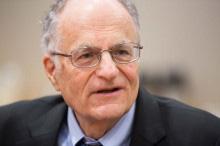
Typical street scene in Santa Ana, El Salvador. (Photo: iStock)
IMF Survey : Thomas Sargent Recounts History of U.S. Debt Limits
December 23, 2015
- Nobel Laureate Sargent explains the history of debt limits
- Role of debt limits has changed over time
- Economic doctrines in the minds of policymakers are important
In a recent visit to the IMF, Nobel Laureate Thomas Sargent brought to life the economic and financial history of the United States, with stories of how debt limits have evolved over the years before and since the creation of the Bretton Woods Institutions.
![Tom Sargent: If you go back to the 19th century, [debt limits] seem to have been taken seriously (photo: IMF)](https://www.imf.org/-/media/websites/imf/imported/external/pubs/ft/survey/so/2015/_int122315aajpg.jpg)
Tom Sargent: If you go back to the 19th century, [debt limits] seem to have been taken seriously (photo: IMF)
Richard Goode Lecture
On December 2, Thomas Sargent, 2011 Nobel Laureate in Economics, delivered the inaugural Richard Goode Lecture at the IMF. Convened by the IMF’s Fiscal Affairs Department (FAD), the Richard Goode Lecture, named after FAD’s first director, who served from 1965–1981, is designed to bring together annually academia and policymakers to discuss important topics of fiscal policy.

Sargent: I believe that the economic doctrines that are in policymakers’ heads are very important.
As noted by David Lipton, First Deputy Managing Director of the IMF, the forum “will offer an opportunity to reflect on the evolution of fiscal policy and think about fiscal challenges that lie ahead.”
In his address, Sargent, the William R. Berkley Professor of Economics and Business at New York University, the Donald L. Lucas Professor in Economics, Emeritus, at Stanford University, and Senior Fellow at the Hoover Institution, discussed the role debt limits have played throughout the economic and financial history of the United States. IMF Survey sat with Sargent to discuss his work on the debt limits.
IMF Survey: Professor Sargent, could you please explain the role debt limits have played in the economic history of the U.S.?
Sargent: Based on the evidence that my friend George Hall and I have assembled, the answer is different before 1917 and after 1939.
Before 1917, there was not an aggregate debt limit. Instead, interestingly, there was a debt limit bond by bond. Congress designed every bond and put a limit on the amount that could be issued. And those limits were taken seriously. They seem to have provided information about what upper bound on what future debt would be, except during wars.
After 1939, an aggregate debt limit was created for the first time. It restricts the par value of the total amount of debt. If you adjust for inflation, in real value, the government debt limit was constant until a little after 1980. It actually went down after 1945. In real terms, the value of debt relative to GDP went down even more. After 1983, nominal debt limits rose and more than inflation except in the Clinton administration. So, as I said, the answer seems to differ substantially after 1939 and before 1917.
IMF Survey: And what was the reason for moving from this bond-by-bond approach to the aggregate limit?
Sargent: Good question. The U.S. Secretary of the Treasury, Andrew Mellon, gave his reasons. After World War I, the federal government had big debts. These debts were in discrete issues of bond of particular maturities. They were issued in big lumps with “echo effects”: lumpy debt service events; potential liquidity and roll-over risks. In the 1920s, the U.S. ran a primary surplus, but not big enough to service all the debt that would come due. So when those big bonds matured, Mellon knew that he was going to have to ask Congress for authority to issue new bonds. He foresaw those “echo effects”. So he asked Congress for authority and flexibility to smooth those things over time. Congress assented. Mellon wanted to manage the debt in ways that would increase the liquidity and allow him freedom basically to be a good portfolio manager.
It is interesting why Congress assented to Mellon’s request while it had denied such requests from earlier Secretaries of the Treasury. You have to know more about the politics of the times than I do to answer that question. The Republicans had big majorities in Congress in the 1920s and they mostly trusted Mellon. Congress evidently thought Mellon’s was a reasonable request and at that time he was respected a lot.
IMF Survey: When would debt limits work effectively in restricting spending?
Sargent: I don’t know. I began this talk [Richard Goode lecture] with a quote from a smart Assistant Treasury Secretary who said debt limits are totally a sideshow, meaning that they are totally irrelevant. Just entertainment. But if you go back to 19th century, they seem to have been taken seriously. In various episodes, they constrained what the President and the Secretary of the Treasury could do, or thought that they could do. Something must have changed between then and now. We are trying to learn more about those changes or at least to frame the question.
IMF Survey: What lessons can policymakers in other countries learn from the U.S.?
Sargent: This is speculative, but the way I look at it is that any decision maker, whether he or she admits it, has two things: (1) a model about the way the world is put together, and (2) some interests they want to advance or protect, that is their constituents’ interests. To me, they try to do the best they can in terms of their constituents’ interests, given their understanding of the way the world is put together. They have theories of economics, including theories about government fiscal policy, whether it matters or not, how it matters.
I think if you go back in the 19th century and try to read and listen, people talk about their theories. Congressmen and journalists discussed and debated them. Presidential elections were fought about intricate technical matters of monetary policy: the silver standard, the greenback, the gold standard, bimetallism. It looks to me as though people on both sides had a common theory.
I believe that the economic doctrines that are in policymakers’ heads are very important. It is very corny to say it, but it is still true.
IMF Survey: How about the IMF? What can we learn from this history?
Sargent: The IMF was set up for good reasons. Keynes and Harry Dexter White and many other good people wanted to solve problems that had devastated the world economy after World War I: adjusting international monetary policies and international debts. The founders of the IMF had theories about how the international monetary system could be set up to handle adverse events in ways that would attenuate adverse consequences.
I see a pretty straight line: the IMF has embodied that theory in a set of practices. I view it as an important institution that seeks to keep alive the thoughts and concerns of its founders. For better or worse, in some countries, they say we don’t want to do it the IMF way. Well, the IMF way is that you have to respect the government budget constraint, mostly from your own domestic taxpayers’ resources, not from abroad. If you want some good outcome, this is what you have to do. A lot of this is just arithmetic and sensible economics. (Some of the arithmetic is unpleasant—that is one reason they call ours “the dismal science”.) The package of IMF policies is coherent and makes sense.
IMF Survey: What is the most interesting thing you have learned from your work?
Sargent: To me, one of the most fascinating things is how the U.S. Congress and Treasury recognized and managed rollover risks and interest rate risks; and how they thought about the sources of the fundamentals that drove interest rate risk, some under the government’s control, some not. Many of their discussions and decision seem very wise and modern. The government did various things about rescheduling and issuing callable debt and exercising call options. It was quite a sophisticated operation, done 150 years ago. We are trying to understand: (1) were those good things to do; and (2) what motivated those decisions.
IMF Survey: What’s next for your research?
Sargent: Debt limits are just a part of what we are doing. We are digging deeper and trying to find interesting stories behind individual episodes. Then, we hope to tell some convincing stories—and supplement them with sensible analysis.


